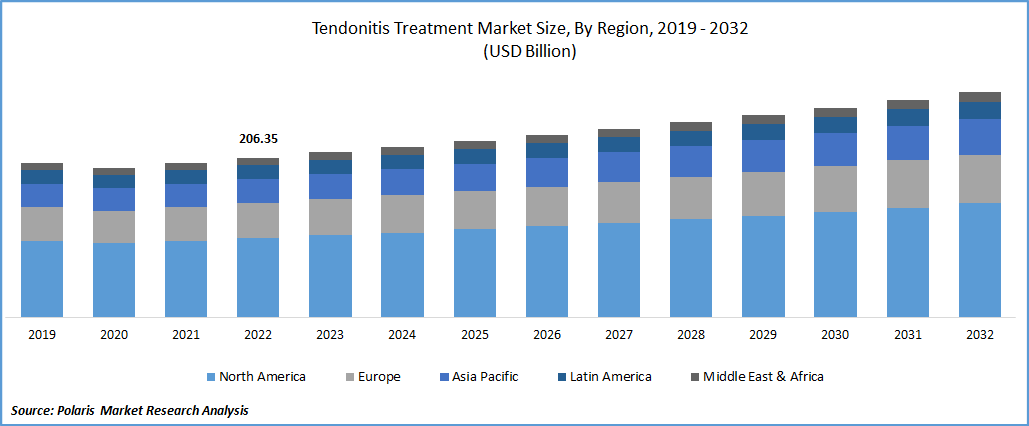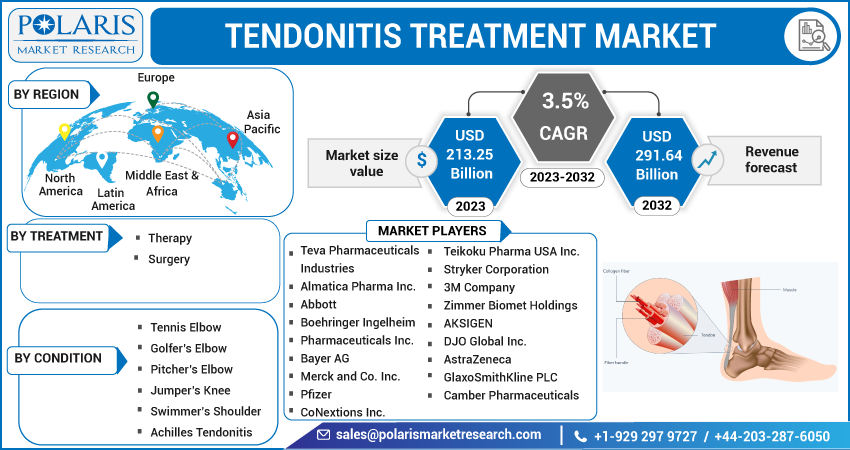
Tendonitis Treatment Market Share, Size, Trends, Industry Analysis Report, By Treatment (Therapy and Surgery); By Condition; By Region; Segment Forecast, 2023-2032
- Published Date:Jun-2023
- Pages: 114
- Format: PDF
- Report ID: PM3383
- Base Year: 2022
- Historical Data: 2019-2021
Report Outlook
The global tendonitis treatment market was valued at USD 206.35 billion in 2022 and is expected to grow at a CAGR of 3.5% during the forecast period. The continuous rise in the aging population and sports & occupational work injuries across the globe and the growing prevalence of adolescents that are susceptible to arm, wrist, and hand-related injuries because of the increasing usage of electronic devices among all age category people are the primary factors boosting the demand and growth of the global market. In addition, the rising incidences of several types of diseases, including bone disorders, osteoarthritis, osteoporosis, and rheumatoid arthritis, which leads to high chances for the geriatric population to being susceptible to tendonitis, are also likely to fuel the adoption of therapies and treatment for the patients all over the world.

To Understand More About this Research: Request a Free Sample Report
Moreover, with the rising inclination towards the major adoption of a healthy lifestyle and noticeable growth in the participation of the global population pool in a wide range of sports activities, thereby fueling the possibilities of sports-related injuries, which in turn, is likely to create several lucrative avenues for the companies operating in the market. In recent years, patients are increasingly opting for non-surgical treatments such as physical therapy, orthotics, and regenerative therapies like platelet-rich plasma and stem cell therapy, as these treatments are less invasive, have fewer risks, and have shorter recovery times compared to surgical options, is gaining traction and popularity worldwide.
The outbreak of the COVID-19 pandemic has significantly impacted the growth of the tendonitis treatment market. The emergence of the deadly virus severely impacted supply chains and equipment availability due to imposed lockdowns and several other bans on transportation activities by many government authorities. The healthcare facilities were also focused on treating COVID-19 patients on priority to get control over the spread of the pandemic, which further resulted in a declined number of surgeries and therapies related to tendonitis during the pandemic.

For Specific Research Requirements, Request a Customized Report
Industry Dynamics
Growth Drivers
The advances in the healthcare industry and increasing penetration regarding the development of several new technologies and equipment with improved features, along with the significant increase in research & development activities undertaken by both government and private organizations, are major factors fueling the global tendonitis treatment market growth. Easy access to highly innovative technology and the presence of well-known corporations, especially in developed countries like the US, the UK, Germany, and France, are also prompting market demand and growth. Furthermore, the exponential growth in the regenerative medicine sector, as it has the potential to revolutionize the treatment of tendonitis, along with the growing advancements in technology such as 3D printing, artificial intelligence, and robotics, are presenting new growth opportunities for the development of the market in the forecast period.
Report Segmentation
The market is primarily segmented based on treatment, condition, and region.
|
By Treatment |
By Condition |
By Region |
|
|
|
For Specific Research Requirements: Request for Customized Report
Therapy segment accounted for the largest market share in 2022
The therapy segment accounted for the largest market share in 2022 and will likely retain its market position throughout the forecast period. The growth of the segment market can be largely attributed to the growing preference of patients with tendonitis for various non-invasive treatments, along with the increasing popularity of physical therapy, as it helps relieve patients with chronic tendon cases worldwide. In addition, it is generally a cost-effective treatment option for the condition compared to more invasive treatment and can also be covered by health insurance in several cases, making the treatment more affordable for patients, thereby propelling the segment market growth.
Therapy for tendinotis has emerged as a personalized treatment in recent years that is tailored to the individual patient's needs and further allows the therapist to assess the patient's condition and develop a treatment plan that helps in addressing their specific symptoms and issues, which bodes well for the segment market. The surgery segment is expected to grow at a substantial growth rate over the coming years, which is mainly driven by a rapid increase in technological advancements in surgical techniques and procedures such as arthroscopy and minimally invasive procedures, which made surgery a more viable option for the treatment of tendonitis with improved patient outcomes and reduced recovery time.
Golfer’s elbow segment is anticipated to witness highest growth during forecast period
The golfer’s elbow segment is expected to grow at the highest CAGR during the projected period on account of the rapid increase in the prevalence of lateral elbow tendinopathy and medical elbow tendinopathy coupled with the constant changes in lifestyles of people with being inclines towards several physical activities, including sports activity that fuels the risk of injuries. Moreover, the extensive rise in focus of major key players towards developing innovative products and several cost-efficient treatment solutions with improved capabilities and features are also likely to boost the segment market growth in the projected period.
For instance, in May 2021, Pendopharm introduced the new SportVis, the only hyaluronic acid treatment approved by Health Canada. It is an innovative soft tissue injury treatment offering effective pain relief that helps people to get back to their activities faster.
The Achilles tendonitis segment led the industry market with significant revenue share in 2022, which is highly accelerated to the continuous surge in the incidence of Achilles tendonitis is mainly due to the growing prevalence of sports injuries and the aging population worldwide along with the rapid development of several innovative treatments such as platelet-rich plasma therapy, stem cell therapy, and shockwave therapy.
North America region dominated the global market in 2022
North America dominated the global tendonitis treatment segment market in 2022 and is projected to maintain its dominance throughout the forecast period. A drastic rise in the number of surgeries being performed across the region and an increase in consumer disposable income levels, especially in highly developed countries like the US and Canada, are among the primary factors boosting regional market growth. Additionally, the rapid emergence of a large number of local manufacturers of medical devices and growing penetration for collaborations among established and renowned market players to expand their product portfolio and business geographies are further anticipated to fuel the demand and growth of the market.
Asia Pacific region is anticipated to be the fastest growing region with a healthy CAGR during the projected period, which is largely attributed to increased penetration and prevalence among medical experts, surgeons, and physicians to align with APAC healthcare facilities to support the growing development of patient-centric treatments guidelines as well as protocols coupled with the increasing investments towards the development of advanced and enhanced healthcare facilities mainly in countries like India, China, and Malaysia.
Competitive Insight
Some of the major players operating in the global tendonitis treatment market include Teva Pharmaceuticals, Almatica Pharma, Abbott, Boehringer Ingelheim, Bayer, Merck, Pfizer, Teikoku Pharma, Stryker Corporation, 3M Company, Zimmer Biomet, AKSIGEN, DJO Global, AstraZeneca, GlaxoSmithKline, Camber Pharmaceuticals, and CoNextions Inc.
Recent Developments
- In April 2022, Boehringer Ingelheim announced the launch of RenuTrend, a new and improved stem cell therapy to improve tendon healing and suspensory ligament injuries. The company has received approval in Europe for RenuTrend; it is the first product licensed and is administrated by the intralesional injection and complements the company’s other equine stem cell products.
- In September 2021, Stryker introduced its new “Citrelock Tendon Fixation Device System” without damaging the tendon during the replacement. It consists of a tendon thread with resorbable technology, “Citregen,” made out of citrate, calcium, & phosphate elements essential for bone formation.
Tendonitis Treatment Market Report Scope
|
Report Attributes |
Details |
|
Market size value in 2023 |
USD 213.25 billion |
|
Revenue forecast in 2032 |
USD 291.64 billion |
|
CAGR |
3.5% from 2023– 2032 |
|
Base year |
2022 |
|
Historical data |
2019– 2021 |
|
Forecast period |
2023– 2032 |
|
Quantitative units |
Revenue in USD billion and CAGR from 2023 to 2032 |
|
Segments covered |
By Treatment, By Condition, By Region |
|
Regional scope |
North America, Europe, Asia Pacific, Latin America; Middle East & Africa |
|
Key companies |
Teva Pharmaceuticals Industries, Almatica Pharma Inc., Abbott, Boehringer Ingelheim Pharmaceuticals Inc., Bayer AG, Merck and Co. Inc., Pfizer, Teikoku Pharma USA Inc., Stryker Corporation, 3M Company, Zimmer Biomet Holdings, AKSIGEN, DJO Global Inc., AstraZeneca, GlaxoSmithKline PLC, Camber Pharmaceuticals, and CoNextions Inc. |
FAQ's
key companies in tendonitis treatment market are Teva Pharmaceuticals, Almatica Pharma, Abbott, Boehringer Ingelheim, Bayer, Merck, Pfizer, Teikoku Pharma, Stryker Corporation.
The global tendonitis treatment market expected to grow at a CAGR of 3.5% during the forecast period.
The tendonitis treatment market report covering key segments are treatment, condition, and region.
key driving factors in tendonitis treatment market are growing awareness of tendonitis treatment options.
The global tendonitis treatment market size is expected to reach USD 291.64 billion by 2032.
